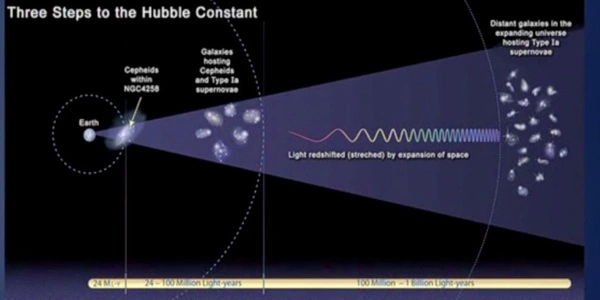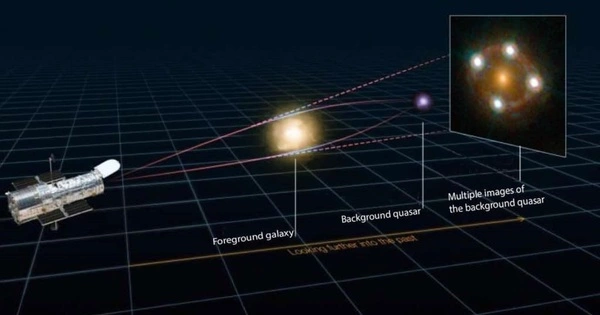NASA’s Hubble Space Telescope has calibrated over 40’milepost markers’ of space and time to assist scientists in precisely measuring the expansion rate of the cosmos – a quest with a narrative twist. NASA’s Hubble Space Telescope has completed a nearly 30-year marathon by calibrating more than 40 “milepost markers” of space and time to let scientists precisely calculate the expansion rate of the cosmos – a mission with a narrative twist.
The search for the rate of expansion of the cosmos began in the 1920s with measurements by astronomers Edwin P. Hubble and Georges Lemaître. This resulted in the discovery of “dark energy” in 1998, a mystery repulsive force that accelerates the expansion of the cosmos. Astronomers discovered another kink in recent years, owing to data from Hubble and other telescopes: a difference between the expansion rate as measured in the local universe and independent measurements from shortly after the big bang, which indicate a different expansion number.
The reason for this disparity is unknown. However, Hubble data, which includes a variety of cosmic objects that act as distance markers, supports the notion that something strange is happening, maybe involving fresh new physics.
“You are getting the most precise measure of the expansion rate for the universe from the gold standard of telescopes and cosmic mile markers,” said Nobel Laureate Adam Riess of the Space Telescope Science Institute (STScI) and the Johns Hopkins University in Baltimore, Maryland.
Riess is the leader of a research partnership named SH0ES, which stands for Supernova, H0, and the Equation of State of Dark Energy. “This is what the Hubble Space Telescope was designed to perform, using the greatest techniques available. This is most likely Hubble’s magnum effort, because it would take Hubble another 30 years to even double this sample size” Riess stated.
You are getting the most precise measure of the expansion rate for the universe from the gold standard of telescopes and cosmic mile markers.
Adam Riess
The publication by Riess’s team, which will be published in the Special Focus issue of The Astrophysical Journal, reports on the completion of the largest and most likely final substantial update to the Hubble constant. The new sample of cosmic distance markers more than doubles the previous sample. His team also reanalyzed all of the prior data, with the whole dataset now including over 1,000 Hubble orbits.
When NASA thought of a huge space telescope in the 1970s, one of the key arguments for the price and exceptional technological effort was the ability to discern Cepheids, stars that shine and dim on a regular basis found inside our Milky Way and in other galaxies. Since astronomer Henrietta Swan Leavitt discovered their utility in 1912, cepheids have been the gold standard of cosmic mile markers. Astronomers utilize exploding stars known as Type Ia supernovae to determine even higher distances.
These objects, when combined, formed a “cosmic distance ladder” throughout the universe and are critical for estimating the universe’s expansion rate, known as the Hubble constant after Edwin Hubble. That value is critical to estimating the age of the universe and provides a basic test of our understanding of the universe.
Beginning shortly after Hubble’s launch in 1990, two teams conducted the first set of observations of Cepheid stars to refine the Hubble constant: the HST Key Project led by Wendy Freedman, Robert Kennicutt, Jeremy Mould, and Marc Aaronson, and another by Allan Sandage and collaborators, who used Cepheids as milepost markers to refine the distance measurement to nearby galaxies. By the early 2000s, the teams declared “mission accomplished,” having achieved an accuracy of 10% for the Hubble constant, 72 kilometers per second per megaparsec plus or minus 8 kilometers per second per megaparsec.
The addition of powerful new cameras onboard the Hubble telescope in 2005 and again in 2009 initiated “Generation 2” of the Hubble constant research as scientists set out to refine the value to an accuracy of one percent. The SH0ES program was the catalyst for this. Several Hubble teams, including SH0ES, have agreed on a Hubble constant value of 73 plus or minus 1 kilometer per second per megaparsec. While numerous methodologies have been employed to examine the Hubble constant, different teams have come up with numbers that are near to the same.

The SH0ES team includes long-time leaders Dr. Wenlong Yuan of Johns Hopkins University, Dr. Lucas Macri of Texas A&M University, Dr. Stefano Casertano of STScI, and Dr. Dan Scolnic of Duke University. The project was designed to bracket the universe by matching the precision of the Hubble constant inferred from studying the cosmic microwave background radiation leftover from the dawn of the universe.
“The Hubble constant is a unique number. It can be used to thread a needle from the past to the present to test our understanding of the universe from beginning to finish. This required a tremendous amount of meticulous labor “Dr. Licia Verde, a cosmologist at ICREA and the ICC-University of Barcelona, spoke about the work of the SH0ES team.
Hubble was used to measure 42 of the supernova milepost markers. Hubble has logged as many supernovae as possible for gauging the universe’s expansion because they are witnessed bursting at a rate of around one per year. “We have a comprehensive sample of all the supernovae visible with the Hubble telescope in the last 40 years,” Riess stated. Like the lyrics from the song “Kansas City,” from the Broadway musical Oklahoma, Hubble has “gone about as fur as it c’n go!”
Weird Physics?
The universe’s expansion pace was projected to be slower than what Hubble observes. Astronomers predict a lower value for the Hubble constant by combining the Standard Cosmological Model of the Universe and measurements from the European Space Agency’s Planck mission (which observed the relic cosmic microwave background from 13.8 billion years ago): 67.5 plus or minus 0.5 kilometers per second per megaparsec, compared to the SH0ES team’s estimate of 73.
Given the massive Hubble sample size, there is only a one-in-a-million probability that astronomers are wrong due to an unfortunate draw, according to Riess, a usual threshold for taking a subject seriously in physics. This discovery is unraveling what was becoming a neat and clean picture of the universe’s dynamical evolution. Astronomers are baffled as to why the expansion rate of the local universe differs from that of the primeval cosmos, but the answer may entail more physics of the universe.
Such perplexing discoveries have made life more interesting for cosmologists like Riess. They began measuring the Hubble constant to benchmark the cosmos thirty years ago, but it has since evolved into something far more intriguing. “I don’t really care what the expansion value is, but I like to utilize it to learn about the universe,” Riess continued.
NASA’s upcoming Webb Space Telescope will build on Hubble’s work by displaying these cosmic milepost marks at longer distances or with better resolution than Hubble is capable of.
The Hubble Space Telescope is a NASA-ESA international collaboration project (European Space Agency). The telescope is managed by NASA’s Goddard Space Flight Center in Greenbelt, Maryland. Hubble science operations are managed by the Space Telescope Science Institute (STScI) in Baltimore, Maryland. The Association of Universities for Research in Astronomy in Washington, D.C. manages STScI for NASA.





